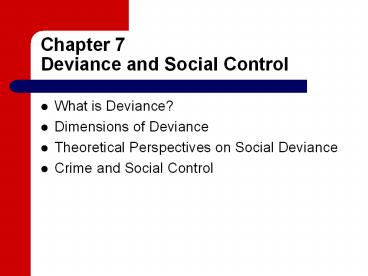Chapter 7 Deviance and Social Control - PowerPoint PPT Presentation
1 / 9
Title:
Chapter 7 Deviance and Social Control
Description:
... behaviors and lifestyles that are opposed to the dominant culture of the society. ... Dimensions of Deviance Theoretical Perspectives on Social Deviance Crime and ... – PowerPoint PPT presentation
Number of Views:289
Avg rating:3.0/5.0
Title: Chapter 7 Deviance and Social Control
1
Chapter 7Deviance and Social Control
- What is Deviance?
- Dimensions of Deviance
- Theoretical Perspectives on Social Deviance
- Crime and Social Control
2
What Is Deviance?
- Behavior that violates the norms of a society.
- Every society creates its own forms of deviance.
- Punishment of deviant acts reaffirms the
commitment of a societys members to its norms
and values and reinforces social solidarity.
3
Deviant Subcultures
- Includes a system of values, attitudes, behaviors
and lifestyles that are opposed to the dominant
culture of the society. - Members are also members of the larger society.
- Within the subculture, members pursue values that
are opposed to those of the larger culture.
4
Biological Explanations of Deviance
- Relate criminality to physical features or body
type. - Early sociological theories of deviance viewed
crime and other forms of social deviance as
attributed to the evils of city life.
5
Functionalist Theories of Deviance
- Mertons typology of deviance is based on how
people adapt to the demands of their society. - Through socialization, people learn what goals
are approved of in their society and the approved
means of achieving those goals. - Individuals who do not accept the approved goals
are likely to engage in deviant behaviors.
6
Cultural Conflict Theories of Deviance
- Cultural conflict concentrates on the ways in
which conflicting sets of norms result in
situations that encourage criminal activity. - Marxian emphasizes class conflict, explaining
various types of crime in terms of the
social-class position of those who commit them.
7
Interactionist Theory of Deviance
- Societys reactions to certain behaviors is to
brand or label the offender as deviant. - Focus on
- Why some people become deviant whereas others do
not. - The creation of new categories of deviance in a
society.
8
Functions of Prisons
- Deterrence
- Rehabilitation
- Punishment
9
Prisons
- Do not seem to deter crime.
- Numerous studies show that prisons are not
successful at rehabilitation and often serve as
schools for crime. - Rehabilitation programs that are effective give
inmates job training and work experience.































